blot
Blot is a plotting library written in C, that plots data onto a string buffer.
That’s right, there are no images, just text – see examples below.
There is a C++ wrapper provided, as well as a CLI tool.
Site: bartman.github.io/blot
GitHub: github.com/bartman/blot
Copyright © 2021-2025 Bart Trojanowski
Licensed under LGPL v2.1, or any later version.
Noteworthy features
- plots to the console as text (by calling
puts()/printf())
- very very fast (compared to python alternatives)
- very very memory usage friendly
- can plot multiple datasets on one canvas
- uses familiar figure based API (similar to existing python plotting frameworks)
- supports braille plotting (like plotille)
- data arrays can be provided in various types (
int16, int32, int64, double, or float)
- there is a C++ wrapper, with limited features, for convenience
- there is a CLI tool that can plot from files or using output of commands
Prerequisites
blot is developed on NixOS and Debian, and CI tested on Debian and Ubuntu.
It is built using standard tools. The dependency script will install the
required packages if you’re on a Debian-based distro.
Packages that blot needs: make ninja cmake glib2 googletest.
Building
blot is built using cmake and ninja. There is a top level Makefile only to
simplify the build process (it invokes cmake in the build subdirectory).
You can build debug (with ASAN) using
Run make help for a full list.
blot CLI
The easiest say to use blot is to use the CLI, which is able to read from files
or launch programs, then plot the numbers it finds.
See the online help for a full list of features…
❯ blot --help
```sh
SYNOPSIS
blot [-h] [-V]
blot [-v] [--debug] [--timing] [-i ] [-A|-U|-B] ((scatter|line|bar)
([-R ] | [-F ] | [-P ] | [-X ] | [-W ])
[-p <y-pos|x-pos,y-pos>] [-r ] [-l ] [-c ] [-i ])...
OPTIONS
-h, --help This help
-V, --version Version
Run modifiers:
-v, --verbose Enable verbose output
--debug Enable debug output
--timing Show timing statitiscs
-i, --interval Display interval in seconds
Output:
-A, --ascii ASCII output
-U, --unicode Unicode output
-B, --braille Braille output
Plot type:
scatter Add a scatter plot
line Add a line/curve plot
bar Add a bar plot
Plot data source:
-R, --read Read file to the end, each line is a record
-F, --follow Read file waiting for more, each line is a record
-P, --poll Read file at interval, each read is one record
-X, --exec Run command, each line is a record
-W, --watch Run command at interval, each read is one record
Data source parsing:
-p, --position <y-pos|x-pos,y-pos>
Find numbers in input line, pick 1 or 2 positions for X and Y values
-r, --regex Regex to match numbers from input line
-l, --limit How many historical values to retain for plotting
Plot modifiers:
-c, --color Set plot color (1..255)
-i, --interval Set sampling interval in seconds
EXAMPLES
blot --braille \
line --color 10 --read x_y1_values -p 1,2 \
scatter --color 11 --read x_y2_values -p 1,2
blot --braille \
scatter --color 11 --read y_values \
line --color 10 --exec 'seq 1 100'
blot --braille \
line --poll /proc/loadavg --position 1 \
line --poll /proc/loadavg --position 2 \
line --poll /proc/loadavg --position 3
```
</details>
First, pick a plotting mode, there are 3 choices: `scatter`, `line`, and `bar`.
Multiple plots can be overlayed.
Each plot needs to get data from a file or process, and there are 5 options:
- `--read ` to read lines data from a file, stop at the end.
- `--follow ` to read lines data from a file, but wait for more data (`Ctrl-C` to stop).
- `--poll ` to poll a file (like `/sys` or `/proc` files), at some interval, and plot the results.
- `--exec ` to run a program that will give us data to plot on successive lines.
- `--watch ` to run a program that outputs one number per execution, which will be accumulate and plotted.
Let's look at some examples.
### plot numbers from a file (read file mode)
Let's say we have a file that contains some X,Y pairs...
```
0 10
1 25
2 0
3 40
4 55
```
We can plot this using...
```sh
❯ blot bar --read mydata --position 1,2
```
The values 1 and 2 are positions in each line where `blot` will find the X,Y coordinates.
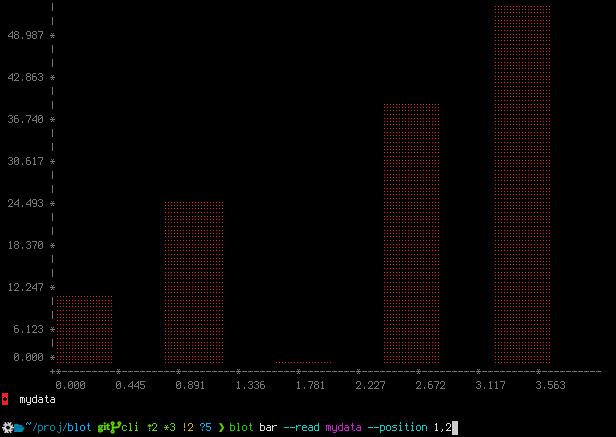
### plot numbers from a log file (follow file mode)
Let's say that we have a log file, with some magnitude values.
Let's just make something up with a script...
```sh
#!/usr/bin/env bash
while true ; do
echo $RANDOM
sleep 1
done > mydata
```
While the above is running, we can plot the data being generated...
```sh
❯ blot line --follow mydata
```
The file contains only one number per line, and `blot` will use the line number as the Y coordinate.

Plot will update continuously, until `Ctrl-C` is used to stop.
### plot the system load (poll file mode)
Recall that `/proc/loadavg` has 3 load values (1,5,15 minutes). We can plot them...
```sh
❯ blot line --poll /proc/loadavg --position 1 --interval 0.5 \
line --poll /proc/loadavg --position 2 \
line --poll /proc/loadavg --position 3
```
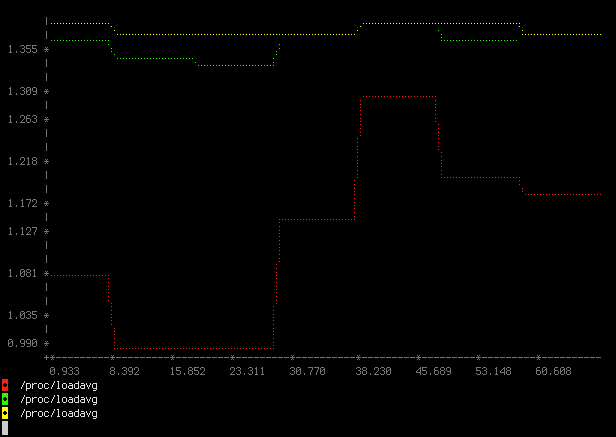
### read X,Y from command line (exec mode)
Here is a cool way to test your random number generator, generate two consecutive numbers and plot them against one another.
```sh
❯ blot scatter --exec 'for ((x=0;x<10000000;x++)) ; do echo $RANDOM $RANDOM ; done' --position 1,2
```
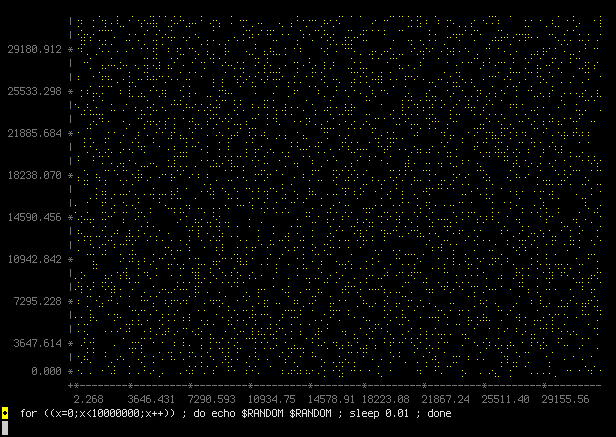
### plot power draw of a GPU (watch mode)
The Nvidia graphics tools provide a system management interface CLI, named `nvidia-smi`.
If we wanted to plot the average power draw, then we could do this...
```sh
blot --timing line --watch 'nvidia-smi --id=0 -q | grep -m1 "Average Power Draw"' --interval 0.1
```
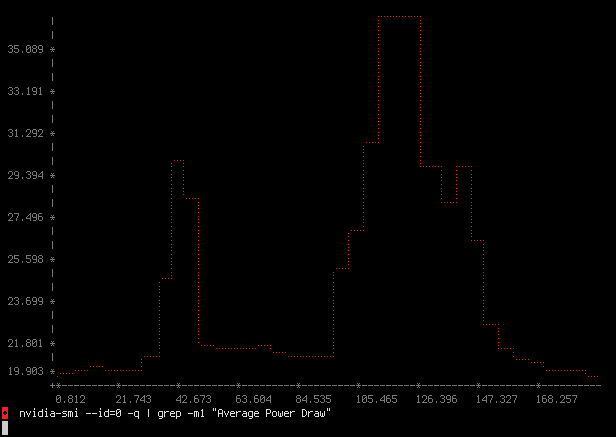
## Source code examples
`blot` is being used in other projects as a library, and it comes with many
examples for the C and C++ usage.
Generated from [simple.c](/blot/examples/c/c-simple.c) (see also [simple.cpp](/blot/examples/cpp/cpp-simple.cpp) for C++ wrapper usage)
./build/examples/c/c-simple
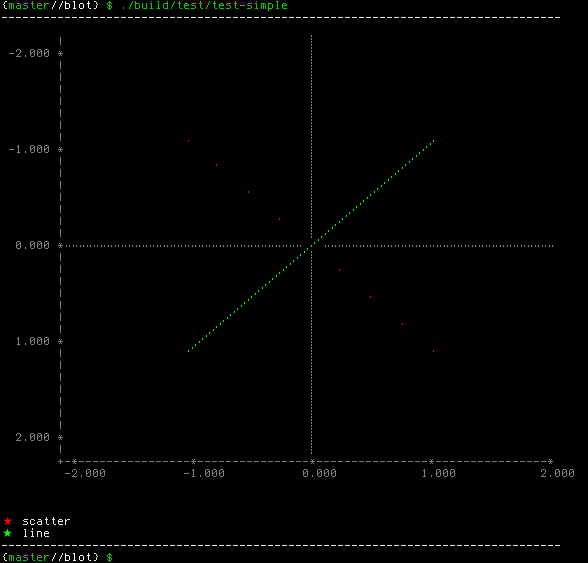
Generated from [trig.c](/blot/examples/c/c-trig.c) (see also [trig.cpp](/blot/examples/cpp/cpp-trig.cpp) for C++ wrapper usage)
./build/examples/c/c-trig
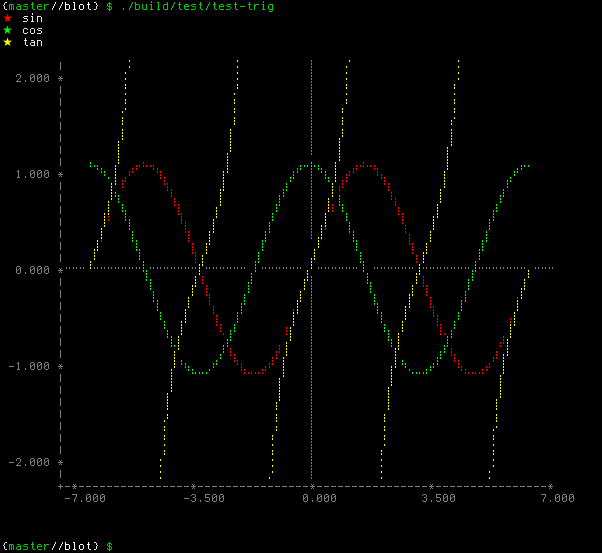
## Missing features
* different plotting modes like histograms (currently only plots line/scatter/bar)
* improve axis line and numbering (currently not very accurate)
* add axis labels and minor ticks (configurable)
* draw origin lines and minor tick lines (configurable)
* better 256 colour support
### Ideas:
Allow for swapping data from layer to allow for even faster plotting (allow `blot` to reuse existing allocated structures)
1. create a figure
2. all `blot_figure_scatter` multiple times, have it return the `blot_layer`
3. call `blot_figure_render` and `blot_screen_get_text`
4. then use `blot_layer_new_data` to swap the data
5. repeat from step (3)
## Similar projects
* [plotille](https://github.com/tammoippen/plotille) - Python, "plot, scatter plots and histograms in the terminal using braille dots"
* [Tables-and-Graphs](https://github.com/tdulcet/Tables-and-Graphs) - "C++ Console Table and Graph/Plot Libraries"